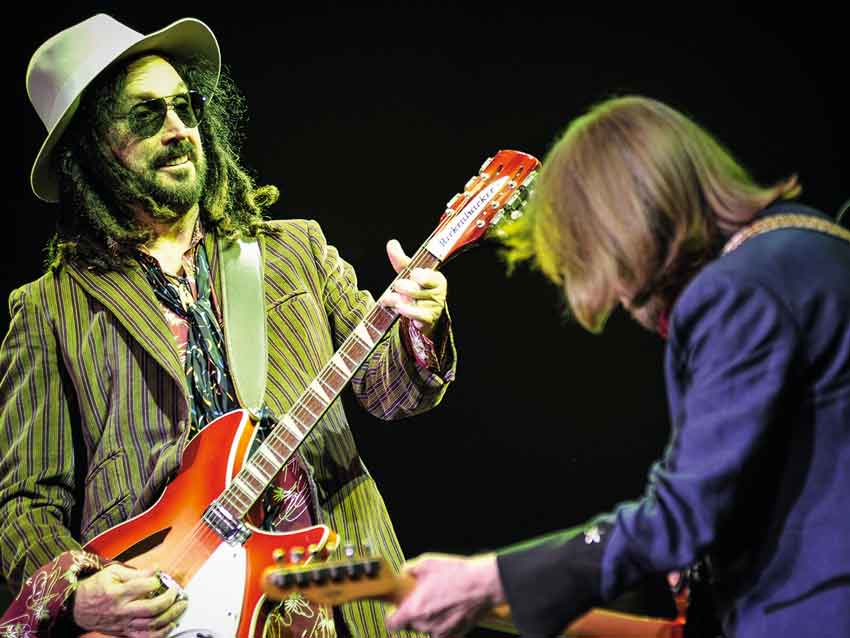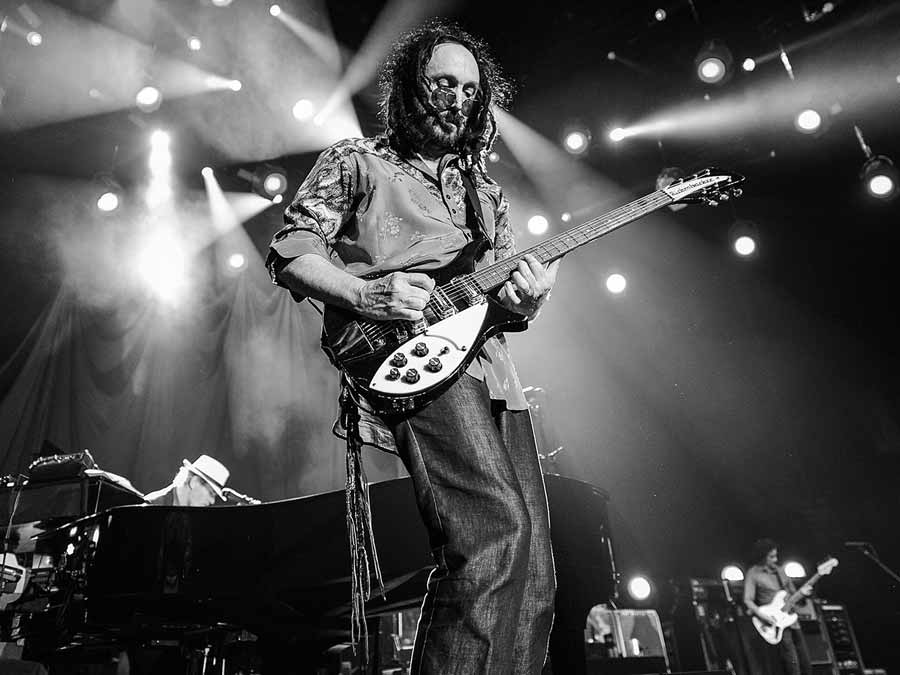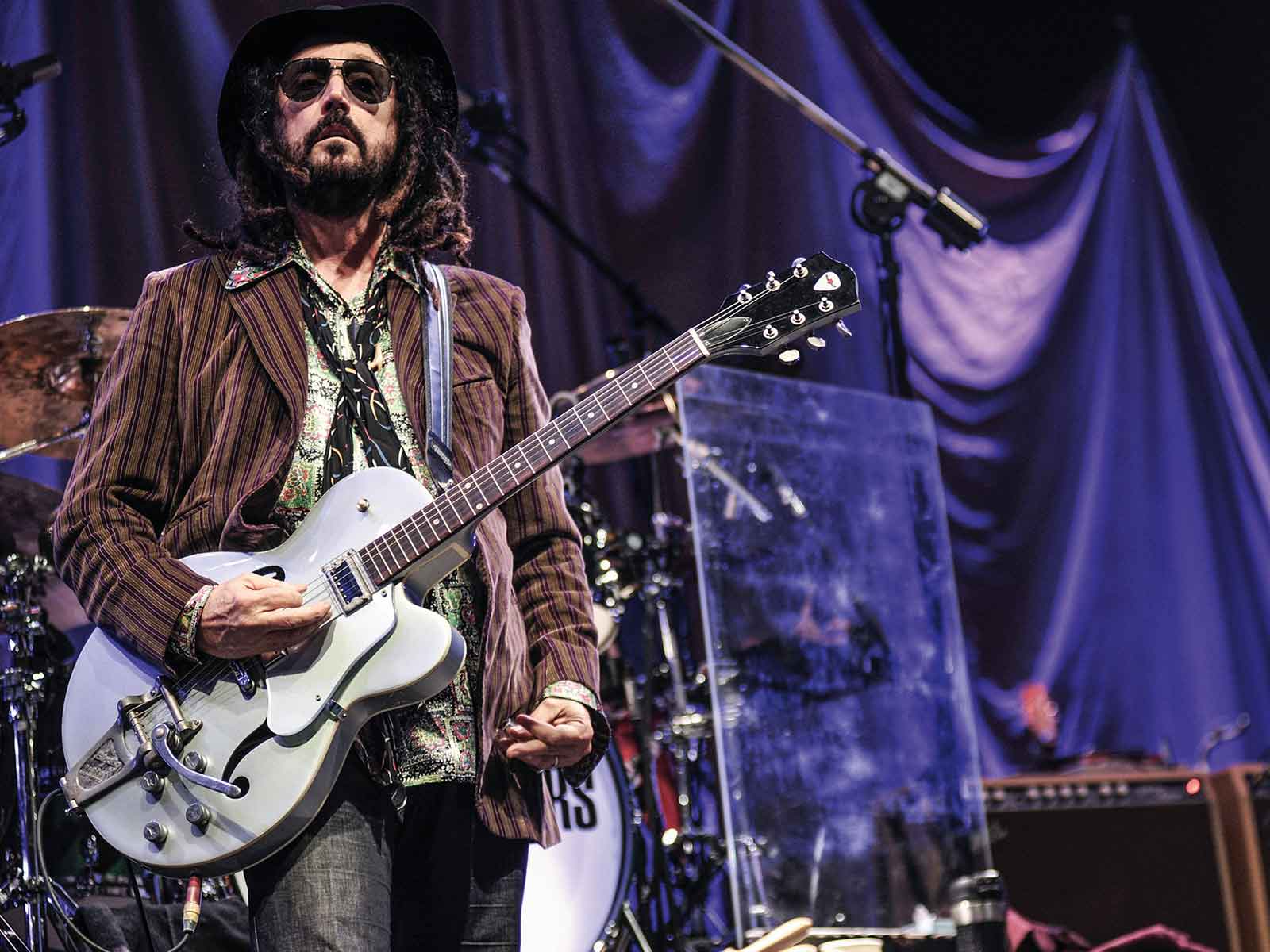Mike Campbell on his many guitars, Heartbreakers and more
40 years and 80 million albums later...

Under pressure
As we begin our nearly two-hour conversation, Mike Campbell admits that even after more than 40 years as the lead guitarist in the venerable Heartbreakers band, the pressure is still on him.
“Madison Square Garden is a big deal,” he begins, ticking off the most memorable shows of their recent 30-date US tour with an almost childlike enthusiasm.
“I was telling somebody the other day, the only place I feel pressure when we tour is the Garden. The Garden has always been one of my favourite places. It’s got so much history.
"The Garden has always been one of my favourite places. It’s got so much history."
"I’m always proud to play there. Also LA, because that’s sort of our home town, maybe Chicago and, on this tour, Seattle and Fenway Park in Boston. We’d never played Fenway and that was epic. So I feel pressure to be at my best. But throughout the whole tour I felt the band played really well, and I was very proud of everybody.”
First No 1
Campbell should be proud. The band are playing better than ever and they scored their first No 1 album with last summer’s Hypnotic Eye, as much of a back-to-basics rock ’n’ roll album as they’ve made since breaking through the New Wave clutter in the late 1970s.
“I think especially the singing sounded really young,” Campbell says when we ask him what, after making so many albums, was different this time around.
“I told Tom that and he was really happy. As long as we’ve been doing this, we still draw from the same places and people who inspired us when we were young. But we also draw from what we’ve already done, and we try not to repeat ourselves.
"As we’ve gone along, that’s become a bit of a good problem to have. But there was no specific discussion when we came to make Hypnotic Eye that we’re going to draw from a specific part of the well, because each song just comes in from wherever it comes. If it fits into a certain bag or feel, I think generally that’s an accident!
"I believe strongly that you just take whatever the gift has given you that day. You don’t say, ‘Oh, this is the wrong well, so I’m not going to take it!’ You take what you’re given, and hope it’s from a good place.”
The well that Petty, Campbell and company draw from certainly is deep. With more than 80 million albums sold worldwide, and countless anthems – from Refugee to American Girl and Free Fallin’ to Mary Jane’s Last Dance – under their belts, the Rock And Roll Hall Of Famers are in the DNA of an audience that encompasses all ages and walks of life.
But it all started playing friends’ parties and school dances in Gainesville, Florida. Campbell has been at Petty’s side throughout. And, like any guitar lover, he remembers it all via the guitars he crossed paths with along the way...

A certain vintage
“My dad always used to play Elvis records,” Campbell recalls of his first musical inspirations.
“He was in the Air Force, and he’d come home from work, take off his uniform, and put on an Elvis record. Meanwhile, I fell in love with Scotty Moore’s playing. Then, of course, a few years later, I saw The Beatles on Ed Sullivan like everybody else my age, and I figured, ‘Well, that’s what I want to do!’
“My very first guitar, when I was 14, was pretty much unplayable. My mom went to a pawn shop and got me a Harmony acoustic. It was an f-hole model and it wasn’t a good one. They do make some good ones, but this was not a good one. But I didn’t know any better! I thought that it was just the way guitars were.
"I could hardly push the strings down, and I figured, ‘Man, these guys I’m watching play the guitar must be strong!’ Then I went to my friend’s house and he had an SG. He handed it to me and I pressed the strings down and was like, ‘My God, you don’t have to bleed!’”
Soon, Campbell graduated to electric and met Petty. “My dad was on tour in Okinawa and sent me a $60 Goya electric six-string,” he tells us. “It was… playable. I actually auditioned for Tom on that thing. They laughed at me when I walked in and played it, but once I played Johnny B Goode, they quit laughing.”
Campbell and Petty connected, and he became a member of Mudcrutch, Petty’s band at the time who were part of the burgeoning Southern rock scene (and who reunited for an album in 2008).
"That was my guitar for several years until Tom sat on it and broke the neck off of it"
“The first nice guitar I got was a Gibson Firebird at a pawn shop when we were on tour in Alabama,” says Campbell of his earliest days as a professional musician. “The guy who ran the shop said they had a really ugly one in the back, and then brought out this red, three-pickup Firebird.
"That was my guitar for several years until Tom sat on it and broke the neck off of it. Then I got a ’64 Strat, which I still have, and we’ve played on almost every record we’ve done.
"It was Tom’s guitar in the early years for quite a while. Once we started making money, we were just buying them left and right. We were out of control!”Over the years, Campbell has picked up a laundry list of dream instruments.
Some were iconic, on his wish list from his earliest days playing the guitar. Others he and Petty made iconic, such as the Fender Broadcaster he played on Breakdown and most of the Heartbreakers’ early records.
“That’s my favourite,” Campbell admits. “I bought and used it on the early records and I still use it on some records. It’s just a magic guitar. It’s kind of a Butterscotch Tele. That’s my favourite. Fender’s doing a reissue of that Broadcaster. They’ve cloned it for me and are going to reissue that soon. I’ve seen the prototype and it’s incredible.
"But I also have a ’59 kind of Jimmy Page one that’s really great, and I have one that’s a ’56, too. I didn’t know better and put a string bender in it! That’s one of my favourites as well, but the Broadcaster is the one. On a lot of records, you hear certain chords, and that’s what makes the record, that tone.
Safe at home
I don’t take it on the road anymore. It’s just too valuable now, and I’m afraid it’ll get damaged. I did take it out to one of the local gigs back when we were doing a soundcheck in LA, and [front of house engineer Robert] Scovill came out and said, ‘What’s that? It sounds better than any of your other guitars!’ I told him I leave it at home but I use it in the studio. I just don’t want to have someone damage it or drop it.”
As for the infamous Rickenbacker that accompanies Petty on the cover of 1979’s Damn The Torpedoes, Campbell says it’s as important to him as it is to every guitar lover who’s stared at it over the years.
"They said it was the next guitar off the assembly line after George Harrison’s"
“That’s my original 12-string,” he explains. “It’s a little-body one. I got it for $120. Later, I took it to Rickenbacker, and they said it was the next guitar off the assembly line after George Harrison’s. So it has the same wiring and sound as George’s. That’s a beautiful-sounding guitar, too, but it’s so valuable now that I leave it at home.”

The Right Voice
Two other Rickenbacker guitars in his arsenal, however, are never far from reach.
“There’s a special story behind that guitar,” Campbell says of the black Rickenbacker he plays on American Girl, closing just about every show. “It’s a six-string. We used to call it the mystery guitar.
I bought it like it looks now, with the three pickups and the John Lennon body. But looking at it closely, we figured out that it was probably a red guitar that’s the same model as the small-body one from the Torpedo cover. We think whoever had it filed the horn down to make it look like John’s and painted it black. I use that on American Girl because it’s got the right tone, and we lowered the key on that song a half step over the years. When you turn down the other Ricks, they get a little sloppy with the lower pitch, but this one sounds great.”
His favourite 12-string at the moment is also, of course, a Rickenbacker.
“It’s a ’67, which I actually bought a couple of tours ago in New Jersey,” Campbell says. “The North East has been good to me! That guitar has the tone.
"I have another one from the mid-60s that I use on Free Fallin’, Roger McGuinn-style [a 360 with single, rear binding]. But the ’67 is George-style [double-bound] from A Hard Day’s Night. It’s just like heaven. It sounds incredible. If I had to pick one, I’d pick that. I use the ’67 on [So You Want To Be A] Rock ’N’ Roll Star. It sings. It’s so easy to play. No matter what you hit, it sounds beautiful.”
Campbell is famed for the wide variety and sheer number of guitars he brings along to a show. Another favourite we have to ask about is his mysterious pale blue Gretsch.
“I bought that Gretsch on tour for $200 one day from a video store,” he says with a laugh. “I was walking around in Hartford, Connecticut and saw they had an SG Junior and the Gretsch Clipper. I bought those two guitars for $200 a piece.
"The Clipper had one pickup in it; a bass pickup. I added a treble pickup and it became a really nice guitar. I’ve refinished it since that day. It had a weird kind of Formica finish when I got it, but I put a pale blue finish on it.”
With so many guitars, is there one that Campbell would choose if he had to?
“The truth is, I could do our whole show with one guitar if I wanted to,” he admits.
“I could play the whole show with a Tele or a Les Paul or an SG. I could make it work. It’d be okay. But there are certain songs where I use a certain guitar on the record that just has a certain colour and when I use the same guitar as I did on the record, it just sounds better because it’s perfectly right for that song.
"On I Won’t Back Down, I have the Gretsch Clipper tuned to an open tuning that I use for that slide part. When I play it on another guitar it sounds okay, but it just doesn’t have the same magic"
"For instance, on I Won’t Back Down, I have the Gretsch Clipper tuned to an open tuning that I use for that slide part. When I play it on another guitar it sounds okay, but it just doesn’t have the same magic it does in that key with that voice. So I always use that guitar on that song.
"Then there were certain songs that were done on a 12-string, so you kind of need the 12-string to make those songs sound special. Those are the things that come to mind. I need different guitars for different things. As the setlist starts to take shape, though, I try to minimise the number of guitar changes as much as I can. But I also won’t sacrifice [tonal] colour for convenience.”

Precious time
As we wind down, we ask Campbell why he doesn’t take to the producer’s chair more often. He’s been a co-producer on some of the most successful albums in rock history. Clearly, he knows a thing or two about what it takes to make great records.
“It’s been a while since I’ve done that, because I realised it’s really a lot of work,” Campbell says with a laugh, though he’s clearly serious about his work ethic. “The part about production I’m a little apprehensive with is that when people come to you to produce their record, you’ve taken responsibility for their career.
"It’s in your hands. If I’m going to produce something, I’m trying to make it the biggest hit I’ve ever made. If it’s not, I’ll feel like I didn’t do my job.
“I realised that when you produce somebody, you really need to give it 100 per cent of your energy. As artists, they have to go on with their career and live with it, while I can produce it and move on to something else.
"I’ll maybe do a song here and there, but to do a whole album is really taking on their life.”
"Occasionally, I hear something that I think I can add to, but for me to bring that artist out the way I think will do them justice is going to take some time out of my life and my career. First of all, I don’t have that much time.
"Second of all,I don’t know if I want to be responsible for their career, you know? I’ll maybe do a song here and there, but to do a whole album is really taking on their life.”
His reluctance, and his clearly busy schedule, leads to an obvious question: with the Heartbreakers on such a high after Hypnotic Eye and a successful tour, how long does he think it will go on?
Got lucky
“The truth is that to have a harmonious group is not easy to do, and we do,” Campbell says, evidently feeling lucky at the longstanding and successful relationship he has with Petty and the other Heartbreakers.
“Look around you. All those bands that broke up far earlier than we did, or all those bands that are still together but just hate each other – that’s not us.
"We actually still like each other and, when we play together, it’s still like the first time in the garage. We still have that kind of awe about what we do.”

